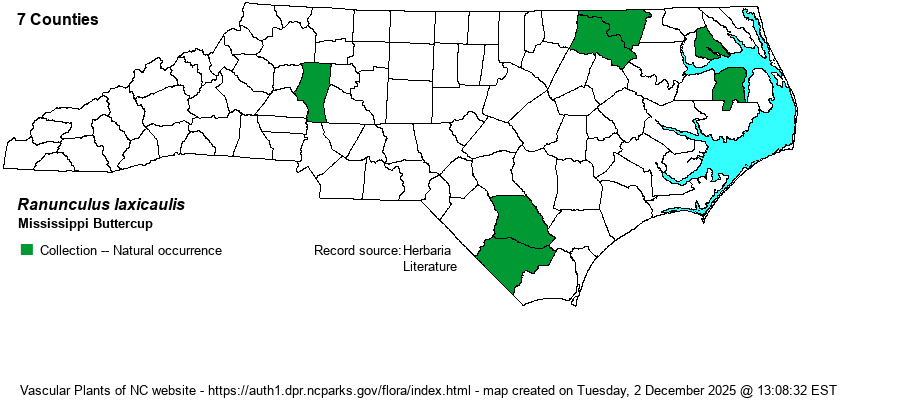| Section 6 » Order Ranunculales » Family Ranunculaceae |
Show/Hide Synonym
| taxonName | relationship | relatedTaxonName | relatedTaxonRefText | relComments |
|---|
|
|
|
|
|
|
|
|
|
|
| Ranunculus laxicaulis | ? | Ranunculus texensis | Gleason and Cronquist (1991) | | | Ranunculus laxicaulis | > | Ranunculus laxicaulis | Godfrey and Wooten (1979, 1981) | | | Ranunculus laxicaulis | > | Ranunculus laxicaulis | Tamura in Kubitzki, Rohwer, & Bittrich (1993). Keys adapted, in part, from C, GW, X, Y, and Z. [also see Ficaria and Hale | | | Ranunculus laxicaulis | > | Ranunculus subcordatus | Godfrey and Wooten (1979, 1981) | | | Ranunculus laxicaulis | > | Ranunculus subcordatus | Tamura in Kubitzki, Rohwer, & Bittrich (1993). Keys adapted, in part, from C, GW, X, Y, and Z. [also see Ficaria and Hale | | | Ranunculus laxicaulis | ? | Ranunculus oblongifolius | Small (1933, 1938) | , misapplied | | Source: Weakley's Flora |
|
| Author | (Torrey and A. Gray) Darby | |
| Distribution | Very poorly known; recorded so far only in scattered middle and upper Coastal Plain counties -- Northampton, Halifax, Perquimans, and Tyrrell in the north, and Bladen and Columbus in the south. Disjunct to a swamp in Iredell County, as reported by Mellichamp, Matthews, and Smithka (1987). Certainly should be found in other places in the Coastal Plain, and possibly even into the Piedmont,
This species is found mainly well west of NC, being found from eastern KS and southern IN south to central TX and LA; records are scattered eastward to the Atlantic Coast, from MD to GA. Most records from MD to GA are from the Coastal Plain. | |
| Abundance | Seemingly very rare to rare, in the upper and middle Coastal Plain, but the abundance is poorly known, as the species has presumably been overlooked as the common R. pusillus or another species, at least when not in bloom. The NCNHP gives it a Watch List status, correctly as W7 (poorly known), but with a State Rank of S2. | |
| Habitat | This is a wetland buttercup species, found in openings in swamps, in muddy ground in marshes and edges, and wet thickets. | |
| Phenology | Blooms from April to June, and fruits shortly after flowering. | |
| Identification | This is a slender species of damp to wet ground, often in sunny places. It has a flowering stalk that ranges to nearly 1 foot tall, well above the basal leaves. These basal leaves have petioles to about 6 inches long, and blades that are quite variable but mostly elliptic and entire, often with a truncate or slightly cordate base, about 1 inch long. The several flowering stems have a few ascending branches, with scattered small leaves. The tips of the branches contain the solitary and medium-sized flower (for a buttercup); the 5 petals are light to medium yellow, with the spread flower about 1/2-inch across. The yellow sepals are shorter than the petals and not obvious. The very common R. pusillus is similar to this scarce species, but that species is a smaller plant in most features -- height, leaf size, etc., but the main separation is that R. pusillus has tiny flowers with only 1-3 petals, and these are barely 1/10-inch long; it is the 5 yellow sepals (1/8-inch long) that are the "petals" of the flower. In summary, you likely will need to see the flowers of this species to be sure that you do not have the very numerous R. pusillus; the vegetative parts are not normally conclusive. | |
| Taxonomic Comments | A few decades ago, R. subcordatus was described, as an endemic NC species. However, recent taxonomic work has shown that it belongs within R. laxicaulis, and essentially no recent references have that species even as a valid taxon now.
| |
| Other Common Name(s) | Coastal Plain Spearwort | |
| State Rank | S2 | |
| Global Rank | G5? | |
| State Status | W7 | |
| US Status | | |
| USACE-agcp | OBL link |
| USACE-emp | OBL link |

